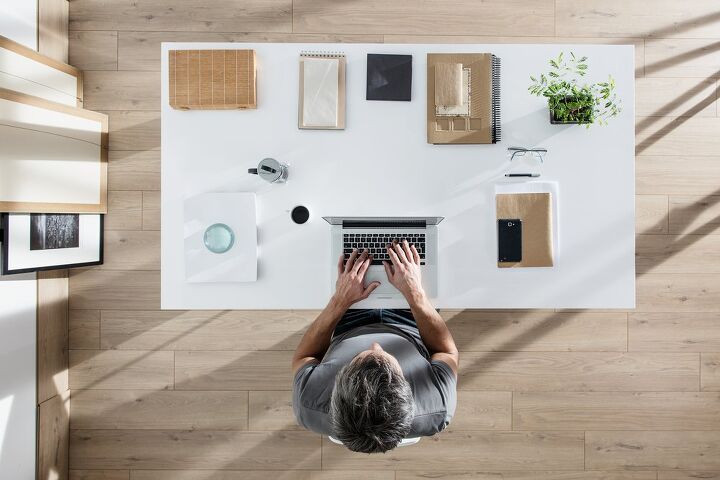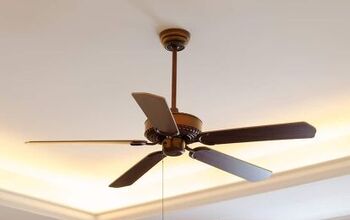14 Types of Desks (with Photos)

From schools to offices to even in the comfort of your own home, you can find desks pretty much anywhere. Of all the different types of furniture pieces out there, desks are among the most common. It is believed that desks have been in use since around the 14th century. Over the last several hundred years, many different types of desks have been invented to satisfy the distinct needs of desk users.
Although they were traditionally used solely for writing and storing documents, the desks of the modern age can now serve a wide array of purposes. Some of the most common types of desks you’re likely to come across include computer desks, writing desks, executive desks, corner desks, and secretary desks. While some of the lesser known desks out there include standing desks, roll-top desks, floating desks, and even treadmill desks.
We’ve assembled a list of the different types of desks, as well as the various materials available to choose from. So, whether you’re searching for a new desk for your office or your work-from-home space, we’re here to help you determine which option is best for you!
14 Types of Desks
1. Writing Desk
You can certainly argue that pretty much any flat surface can be a writing desk – whether it’s your coffee table or even your mattress. However, an actual writing desk is much firmer and more comfortable for doing your writing tasks. The advantage to these desks is that they are incredibly versatile, as they can be used for a variety of projects that require a flat surface.
Writing desks usually have an open, basic design, with minimal storage and thin legs. They provide the perfect surface for writing or working on your computer, but are best suited for a laptop rather than a desktop. These desks come in varying sizes, with the majority of writing desks being roughly 36 inches wide and 24 inches deep. They also range in style from rustic farmhouse to sleek modern.
2. Computer Desk
Although computer desks are relatively similar to writing desks, the key difference between the two is that computer desks typically have additional space for the computer, keyboard, printer, and possibly other components. In most cases, these desks will feature a dedicated keyboard tray, a storage compartment for the CPU, and cut-outs for cable management.
When it comes to size, computer desks are somewhat bigger than writing desks but still smaller than executive desks (which we’ll discuss next). Though, as people have started to make the switch over to smartphones, tablets, and compact laptops, large desktop computers have declined in popularity. Though, a computer desk is still an excellent choice for providing sufficient space for whatever your needs may be.
3. Executive Desk
The executive, or office, desk has a massive footprint when compared to the aforementioned options and is, arguably, the most boisterous piece of home office furniture available. Because of its size, you must have plenty of space if you choose to add an executive desk to your office.
There are essentially three main types of executive desks, categorized based on their design: U-shaped, L-shaped, and open plan executive desks.
- L-shaped executive desks are best suited for positioning in corners or large spaces. This type of desk is connected via a perpendicular wing, known as a ‘bridge.’ It offers tons of surface space for storing your office items and performing multiple tasks. L-shaped desks usually also have built-in file cabinets for storing your documents.
- U-shaped executive desks are similar to the l-shaped design in that they have a bridge that connects a series of desks into a wrap-around shape. They also have plenty of space for organizing your office supplies and equipment and are meant to be placed in large rooms.
- Open plan executive desks are essentially rows of desks, without a divider. Instead of being several desks connected by a bridge, this type of executive desk is just one desk. This type of arrangement has gained popularity recently in the corporate world, as many believe it promotes teamwork among employees.
4. Secretary Desk
Secretary desks are ideal for those who have tons of paperwork and other office necessities that need a home. These desks have been around for quite some time but they’ve undergone a lot of changes over the years. The original secretary desk appears like a mix between a desk and a dresser, with a number of drawers, compartments, and cubbies. There is also a large sliding panel that, when opened, serves as the desktop.
Nowadays, modern secretary desks are far less bulky and smaller in size. Though, most still have the drop-down covers and hidden compartments that these desks are known for. With these covers or panels in the front, it makes it difficult to accommodate large desktop computers and printers. Instead, these desks are more suited for a laptop and mouse setup.
5. Trestle Desk
The trestle desk is a very modern design, and essentially a much more compact version of the writing desk. It offers a spacious work space, in a lightweight, contemporary, and condensed design. Trestle desks are very trendy and wildly popular in European households. They are also gaining popularity in the U.S. as well.
These desks consist of a plank of wood, atop two trestles – one on each side. As such, they are very practical and can be easily moved from room to room, which makes them ideal for smaller homes. For additional storage space, the trestle desk is often paired with a small, rolling file cabinet.
6. Standing Desk
In the last several years, the concern has grown over how unhealthy it is to remain sitting for extended periods of time. This concern has resulted in the increased popularity of standing desks, which is an excellent solution for sitting hours on end in the workplace. These types of desks force the user to stand as they work.
Though, most standing desks are height adjustable so you have the option of switching back and forth between sitting and standing. There are both electric and manual standing desk options, which allow you to find the proper height for your body. Modern standing desks come with a number of impressive features such as LED displays that show the exact height of the desk and even allow you to program in specific heights to access them at the press of a button.
Another popular option for those who want a standing desk but maybe want to spend a little less money is a standing desk converter. This allows you to make use of the desk you already have, as the converter is placed on top of the desk and can be adjusted for either a standing or sitting position as desired.
7. Treadmill Desk
Treadmill desks are another desk option for those health-conscious individuals, as they combine a desk and a treadmill into one piece of furniture. Like standing desks, the desk portion is usually height-adjustable. Whereas, the treadmill itself is situated under the desk.
The arrangement of the treadmill desk allows you to work and work out and the same time. Of course, using a treadmill desk is an excellent way to decrease your sedentary time throughout the day. However, research has shown that using a treadmill desk can actually increase work productivity as well.
8. Floating Desk
Similar to the trestle desk, floating desks are designed to be installed and used in smaller spaces. Also known as an on-wall desk, this desk lacks legs and is mounted directly to the wall, saving all the available floor space. The floating desk is usually mounted alongside cubbies and shelves to take full advantage of the vertical space.
For those with small apartments, homes, or dorm rooms, a floating desk is perfect to give you the workspace you need without taking up too much room. Plus, with some models, you can fold up the desk and get it out of the way when it’s not in use. The main drawback to floating desks is that they must be attached to the studs in your walls, otherwise they risk collapsing under too much weight.
9. Lap Desk
If you prefer working from your bed or couch, you’ll benefit from a lap desk. This type of desk provides a flat, sturdy surface and some height to allow you to work from the comfort of your bed, couch, or virtually anywhere in your home. You can also adjust the height of a lap desk to ensure that you don’t strain your back or neck as you’re writing or working on your laptop.
Believe it or not, lap desks have existed for centuries. In fact, it is said that President Thomas Jefferson had a lap desk made out of mahogany that he used to pen portions of the Declaration of Independence. Though, modern lap desks feature ventilation and padding, as opposed to drawers for storing ink.
10. Corner Desk
As the name indicates, corner desks are designed to be placed in the corner of a room. These L-shaped desks are very appealing because they offer a spacious working surface where you can install several computer screens, and still have space for paperwork on either side.
The main advantage of corner desks is that they provide more workspace in a smaller area. Plus, the additional leg room they offer is a huge bonus!
Another type of corner desk is called a radial desk, which features a curved top (that extends to the left or right side) instead of an L-shape. These desks are very common in commercial office environments and usually come with a small cabinet on wheels.
11. Credenza Desk
Credenza desks, or sometimes referred to separately as a desk and a hutch, combines a desk with shelves and/ or cabinets overhead. Because of their dual function, you’ll often find these desks in living rooms and dining rooms.
Though, they can be an interesting statement piece in a home office. The only major caveat to credenza desks is that you must have the space to accommodate one, as they can be both tall and wide.
12. Hallway Desk
A hallway desk is a type of desk that is slim enough in size to fit in the hallway of a home. They receive their name because they are typically positioned at the end of a hallway. This minimalist piece of furniture is best suited for those who need a desk but don’t plan to use it very much.
These desks usually feature minimal storage and, because of their sleek design, somewhat resemble a French antique accent table. Some might argue that hallway desks are too small for using a computer or writing, but they still offer plenty of value.
13. Pedestal Desk
Put simply, a pedestal desk is simply a type of desk that has columns of shelves or drawers on either side that serve as the legs. They are usually somewhat large, rectangular in shape, and feature a large drawer in the center above where the user’s legs would go. Pedestal desks are ideal for those who need plenty of storage space for their paperwork and documents.
14. Roll-Top Desk
Antique roll-top desks are stunning pieces of furniture, though you can find modern models still being made today. This type of desk is somewhat similar to the secretary desk, with stacked compartments, cubbies, drawers, and shelves mounted atop the workspace. However, instead of a panel that closes it off, the desktop is covered with wooden slats that slide or roll along slots in the desk’s raised sides.
Desk Materials
In addition to desk types, styles, and designs, desktops are made out of a variety of materials. It’s important that you choose the right material, as it dictates the look and feel of the desk when it’s in use. That said, here are some of the most common desk materials you have to choose from:
1. Solid Wood
Traditionally speaking, most desks were made out of wood and served as a rustic example of strength and stability. Nowadays, desks that are constructed out of natural wood provide an organic, welcoming feeling to the office space. In fact, it is incredibly difficult to mimic the timeless quality of natural wood with any other material.
Wood desktop surfaces are the standard form and can be found atop a desk made entirely of wood or mounted on a metal frame. In addition to being durable, with wood, you can choose from a variety of textures, cuts, grains, and species to achieve the look that you desire.
2. Powder-Coated MDF/ Particle Board
MDF, or medium-density fiberboard is a very popular material used to make desks. It is made out of wood scraps that are finely-ground up and combined with a resin or adhesive. Also known as particle board, MDF is subjected to immense pressure that gives it its stability, strength, and lightweight.
While this material is often one of the most affordable options for desks, it is not as durable and is prone to falling apart. Though, the lightweight design makes it easy to install and move around. Plus, desks made of MDF can also be painted should you want to give it a refresh later on. For reference, desks and other furniture items that you purchase from IKEA are typically made out of particle board.
3. Bamboo
Bamboo is one of the most durable variations of natural wood out there, and is highly resistant to damage from everyday use. In fact, bamboo desks are roughly 40% harder than oak or solid wood. Unlike wood, bamboo will not easy rot or swell when exposed to moisture. It is also lightweight, more affordable than hardwood, and economically priced.
4. Glass
Opting for a desk made out of glass can add a modern touch to any office space. Glass desks typically feature a glass desktop and either wood or metal framing. Regardless, the presence of glass magnifies the visual space and lightens up the entire furniture item. The transparency gives the allusion that your glass desk is taking up far less space than it actually is.
These desks can make your home office look both larger and cleaner. Glass desktops are usually removable for moving, cleaning, and general maintenance purposes. They are also available in a wide array of configurations and unique shapes.
While they may not be as durable as other materials, glass office desks are a very sophisticated option. If breakage is a concern, you can always opt for a desk made of acrylic, which imitates the look of a glass desk but offers more durability.
5. Metal
When it comes to utilitarian design, metal desks are the ideal choice. They are easy to clean, as the material resists scuffs, stains, and stays cool to the touch. Metal desks also offer maximum durable and come at an affordable price without needing to be replaced as frequently as most other materials.
Like glass, metal is often paired with another modern material like glass. As previously mentioned, metal is a common material used for the frame of a desk, with either a solid wood or glass top. Though, you can also find traditional wood desks with metal desktops for a high contrast look.

Jessica considers herself a home improvement and design enthusiast. She grew up surrounded by constant home improvement projects and owes most of what she knows to helping her dad renovate her childhood home. Being a Los Angeles resident, Jessica spends a lot of her time looking for her next DIY project and sharing her love for home design.
More by Jessica Stone




























![The 5 Best Angle Grinders – [2022 Reviews & Buyer's Guide]](https://cdn-fastly.upgradedhome.com/media/2023/07/31/9071326/the-5-best-angle-grinders-2022-reviews-buyer-s-guide.jpg?size=350x220)














